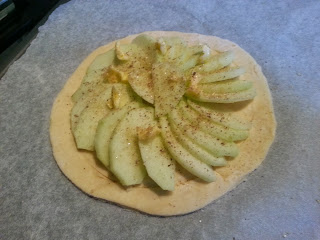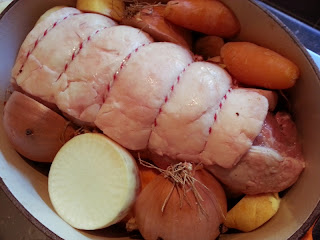The great thing about
celery is that it is two vegetables and one spice all in one.
The large
familiar swollen stems are actually greatly enlarged leaf stalks and make up
most of the plant visible above the soil. The celery we know and love was
selectively bred in 14th century Italy from the wild plant that is
“rank, coarse, and…poisonous” according to the celery expert Theophilus
Roessle. It is these stalks that join onions and carrots to produce the trinity
of stock vegetables – indeed it is for stock, or for salads, that celery is
commonly used, but it does make a great vegetable on its own. It was very
popular to serve celery sauces with poultry, or served covered in a cream sauce
with pheasant, which is what we have here for this recipe.
In Good Things, Jane Grigson gives us
two valuable pieces of advice: firstly, that celery is a seasonal vegetable
that is at its best from November and December. We have lost this seasonality
and it is a shame, I expect few of us have eaten prime celery improved by the
‘first frost’. The second piece of advice is how to eat the vegetable raw; once
you have procured your first-frosted celery, you should trim it and spread down
the curved length of the stem good butter. Next, sprinkle with sea salt. “Avoid
embellishments”, she says “a good way to start a meal.”
It is a myth that
celery is calorie negative: a stick may only contain 10 calories, but it takes
only 2 or 3 calories to chew, digest and process it. It is very low in
calories, of course, and can help you lose weight, though "It's more of a gateway to
cream cheese or peanut butter," says the nutritionist David Grotto.
Indeed. In this case, it’s a gateway to bacon, port and two kinds of cream.
I plucked and drew my own pheasant, that way I could use its giblets for the sauce. For some reason, I decided that I should leave the feet on.
Start off by browning a pheasant in 3 ounces of butter along with a chopped onion in a frying pan. Place the
pheasant breast side down with the onions in a casserole dish. Cut three strips
of unsmoked bacon (aka green bacon)
into thin strips and fry that in the pan briefly. Deglaze the pan with ¼ pint
of port and a batch of giblet stock. See the now positively
ancient post #122
Roast Pheasant for instructions
on how to make some. Pour the stock, port and bacon into the casserole dish,
cover tightly with a double layer of foil. Bake in the oven for 30 minutes at
180⁰C. At this point the legs of my pheasant stuck right out all flexed. At least there would be good handles when it came to the drumsticks.
Meanwhile, wash and slice a whole head of celery and when the 30 minutes is up, turn the bird the right way
up and place celery around, under and within it. Season well with salt and pepper. Pop the foil lid back and give it another 30 minutes.
Remove the bird and place on a warmed
serving plate, arranging the celery and bacon around it. Strain the cooking
liquor into a small sauce pan. Whisk together a quarter-pint each of single cream and double cream along with a large egg yolk. Add this to the saucepan and stir with a wooden spoon
over a low heat until it thickens slightly. Taste and check for seasoning and
add a good squeeze of lemon juice.
Lastly, scatter over some chopped parsley
and serve with the sauce in a sauceboat.
#387 Pheasant
Braised with Celery. This was a great recipe that was not anywhere near as
rich as I expected it to be. The port wine cream sauce was so very tasty and
complemented the still slightly crisp celery perfectly. It’s worth mentioning
that you should use a nice deep-green organic head of celery – and not the
intensively grown stuff you get at the supermarket. Hunt out a local supplier.
The pheasant itself was nicely-flavoured, but a little on the dry-side. An
hour’s cooking was too much for the tiny white lady pheasant I had procured
from my butcher. Luckily, plenty of creamy sauce covered a multitude of sins
and it didn’t spoil this first-class recipe. I didn't cover the claws though. 8/10.
























































